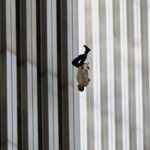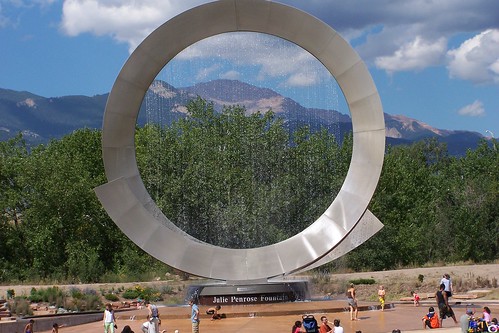1976- With Robert K. Kane as President, and based on directives from the President’s Commission on Olympic Sports named by President Gerald Ford in the aftermath of problems for athletes at the Montreal Games and an ongoing squabble between the NCAA and the AAU related to selection and rights to compete, the USOC seeks to relocate from 57 Park Avenue in New York City and to establish Olympic training centers and a new national headquarters.
1977- USOC selects Colorado Springs for national headquarters over Baton Rouge, LA, and establishes Olympic Training Center at old ENT AFB facility with 35 acres. (The first training center was opened in Squaw Valley, Cal., in early 1977) Olympic legend Bob Mathias is hired to run the Colorado Springs OTC, which welcomed its first athletes in August. The El Pomar Foundation gives the USOC a check for $1 million to seal the deal and the move of Olympic House to the city. IOC selects Los Angeles to host 1984 Olympic Games, backed by USOC’s silent commitment of $25 million against a shortfall.
1978- USOC, now chartered by the Amateur Sports Act in Congress stages first National Sports Festival in June. Olympic House opens on August 1 with Col. F. Don Miller as Executive Director and less than a dozen USOC staff relocate from New York City. More than 25 National Governing Bodies also set up shop in the city, most on complex. USOC quadrennial budget is $19 million. USOC hires CU sports information director Mike Moran as its first executive staff addition from the region.
1979- USOC Stages 2nd National Sports Festival in Colorado Springs with NBC Sports televising the action.
1980- Lake Placid host the Olympic Winter Games and hockey team records the “Miracle on Ice.” President Jimmy Carter reveals demand that USOC boycott the upcoming Moscow Games unless Soviet troops leave Afghanistan.
USOC House of Delegates votes not to participate in the Olympic Games in Moscow after Carter Administration pressure, April 12 at Antlers Hotel. USOC receives deed to Olympic Complex from Springs Industrial Foundation.
USOC funds dry up and organization faces bankruptcy and staff cuts. Don Miller reaches agreement with White House for $10,000,000 emergency grant to save the organization in the boycott aftermath. USOC does not receive the money until 1981 after Ronald Reagan is in office.
1983- USOC Stages Sports Festival in Colorado Springs after San Diego opts out. USOC builds first “new” facilities in Colorado Springs, a multi-sport Sports Center with six gyms and seating for almost 3,000, and the 7-11 cycling Velodrome in nearby Memorial Park: Cost $12.9 million.
1984- USOC backs Los Angeles with $25 million shortfall guarantee and Games produce $227 million surplus. USOC and NGBs receive $143 million of surplus and USOC creates U.S. Olympic Foundation with its share. Financial health is restored. William E. Simon is USOC President since 1980.
1985- USOC Executive Director F. Don Miller retires after leading organization’s relocation and growth in Colorado Springs. He becomes first President of new U.S. Olympic Foundation, with offices in the city. Gen. George Miller (USAF Retired) hired as successor to Miller.
1986- USOC hires John Krimsky, Jr., as chief marketing and fund-raising executive after 27 years at Pan American Airways. He raises more than two billion dollars over the next thirteen years for the USOC, which enjoys its greatest period of growth, to almost 600 employees, a significant new share of U.S. TV rights for the Olympic Games, enhanced sponsor packages and revenue, quadrennial budgets near $500 million, and training centers in Colorado Springs, Lake Placid, and Chula Vista, CA.
1991- Bill Hybl of Colorado Springs selected as Interim President of USOC after turmoil forces resignation of Robert H. Helmick. Hybl creates first USOC Ethics Committee and restores order.
1996- Hybl elected USOC President through 2000; Atlanta stages Centennial Olympic Games and USOC-Atlanta joint marketing effort produces record revenues for the USOC.
1997- USOC opens new, state-of-the-art facilities in Colorado Springs complex, including athlete housing, dining hall, fieldhouse, aquatics center and visitor center, sports medicine center with $23.8 capital construction effort. Some 8,000 athletes now use facility annually.
1998- Olympic Complex Visitor Center welcomes one millionth visitor. Salt Lake bid scandal erupts and USOC reforms its bid city selection process after President Bill Hybl appoints review commission chaired by Sen. George Mitchell. IOC follows with similar reforms.
2000- Norman P. Blake becomes USOC Chief Executive Officer, but resigns after only 10 months in the post. Scott Blackmun is named Interim CEO.
2001- November 1 - Lloyd Ward is named CEO of the USOC and serves until his resignation in March, 2003.
2002- Salt Lake City stages successful Olympic Winter Games and U.S. athletes finish 2nd in the overall medals table, the best finish in history by America’s winter sport athletes.
May 23- USOC President Sandy Baldwin resigns; Marty Mankamyer assumes the post
Nov. 2- USOC selects New York City as its 2012 Olympic Games candidate city in meetings at The Broadmoor Hotel, San Francisco is the runnerup.
Dec. 31- Mike Moran retires as USOC Chief Communications Officer and becomes Senior Communications Counselor for NYC2012, New York’s Olympic bid group and also Chair of Edelman Public Relations Olympic practice. Darryl Seibel is selected as Moran’s successor.
2003- Feb. 5 –Marty Mankamyer resigns post as USOC President; Univ. of Michigan Athletic Director Bill Martin named Interim President
March 1 – Lloyd Ward resigns as USOC Chief Executive Officer; Jim Scherr assumes interim role.
August 1- USOC and Colorado Springs celebrate 25th anniversary of relocation from New York City.
2004- June 15 - Peter Ueberroth named Chair of the new USOC Board, which has only eleven members, down from 125 in 2003, after major reforms.
2005- December- USOC names Jim Scherr as Chief Executive Officer
July 5- IOC selects London as host for the 2012 Olympic Games. USOC nominee New York City is eliminated in the second round of voting.
Olympic wrestler Jim Scherr named USOC Chief Executive Officer after serving interim term since March, 2003, following Lloyd Ward’s departure.
2006- More than 400,000 athletes have used the training facilities in Colorado Springs, which is also home of 22 National Governing Bodies of Olympic Sports, and 54 national or international sports organizations.
Colorado Springs named a USOC Community Partner city after raising $250,000 as part of the effort by
The Colorado Springs Sports Corporation and its partners.
2007- It’s the 30th Anniversary of the opening of the U.S. Olympic Training Center in Colorado Springs. (August) USOC names a building on the Olympic Complex after the late Bob Mathias.
USOC selects Chicago as the nation’s Candidate City for the 2016 Olympic Games on April 14.
With support from the USOC Community Partner Fund, the State Games of America return to Colorado Springs. A record 10.803 athletes from 47 states participate.
The U.S. National Boxing Team selects Colorado Springs as its residence and training site for the year leading to the Olympic Games in Beijing. It’s the sport’s first resident program in almost a decade.
2008- March 31, The USOC selects Colorado Springs to be its national headquarters for at least 25 years in historic announcement following acceptance of city’s incentives package.
30th Anniversary of USOC headquarters relocation from New York City to Colorado Springs (August 1)
Oct. 2 –Larry Probst selected as USOC Chairman
2009- March 5, Jim Scheer abruptly resigns as CEO and is replaced by Board member and former corporate executive and USOC Board member Stephanie Streeter on an acting basis through the 2010 Olympic Winter Games. Chief Communications Officer Darryl Seibel resigns on May 5.
The controversy over the city’s financial commitment to the retention of the USOC and the construction of a new downtown headquarters and Olympic Training Center upgrades widens.
October 2- Chicago is ousted in the first round of the IOC process for the selection of the host city for the 2016 Olympic Games and the USOC comes under withering fire for its souring relationship with the IOC and its impact on the Chicago bid.
Stephanie Streeter announces that she will not be a candidate for the USOC’s CEO position and a national search is launched.
2010- Jan. 6 - Scott Blackmun is selected as the USOC’s Chief Executive Officer after a national search and soon announces that the organization’s most important annual gathering, the U.S. Olympic Assembly, will be staged in Colorado Springs in September, a positive signal to the citizens and leaders in the city about the USOC’s commitment to its hometown. Patrick Sandusky is named as Chief Communications Officer on February 3 after serving in an acting role for several months.
Blackmun moves quickly to make a public commitment to repairing the USOC’s relationship with Colorado Springs, closing the Irvine, CA, International relations Office and relocating it to the new downtown Colorado Springs headquarters building.
USOC moves into new downtown headquarters in April, relocating more than 200 employees to the new location from the Olympic Complex in mid-town.
Blackmun announces a menu of community outreach efforts and programs designed to support the USOC’s commitment to Colorado Springs, including several major meetings, citywide events, staff participation with local organizations, and communication.



















.jpg)



















































